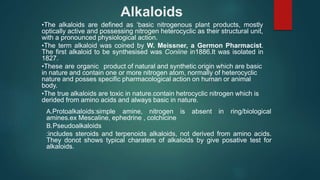The document provides an extensive overview of alkaloids, which are basic nitrogenous plant products with significant physiological effects. It categorizes alkaloids into true alkaloids, protoalkaloids, and pseudoalkaloids, and details their chemical properties, classification, and tests for identification. Additionally, it discusses specific alkaloids from plants such as Vinca rosea and Rauwolfia serpentina, including their cultivation, medicinal uses, and potential side effects.



































































